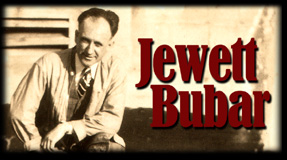Career Overview
Jewett Walter Bubar was born in October, 1883 in Linneus,
Maine. The 11th child of the town's Baptist minister, he migrated
to California with his mother and several brothers and sisters sometime
after his father's death in 1895.
The family settled in Salinas,
California around the turn of the 20th Century. It was there that
Jewett met and married Nell McKellips in nearby Pacific Grove in
1907. The previous year he had served in the California National
Guard, and had done duty in San Francisco, keeping civil order after
the Earthquake and Fire.
Jewett and Nell eventually moved to Berkeley, California, sometime
around 1910. At that time, Bubar began painting commercial art -
in the form of small signs and "cards" -the work often
solicited from small business owners by his wife. He also is known
to have done larger accounts - such as his part in creating the
artwork (and possibly the slogan) for the famous "M.J.B. -
Why?" coffee ad campaign in the 'teens. An original rendering
of one of his M.J.B. billboards exists today on the side of an old
commercial building in Oakland's restored commercial district, near
its present-day convention center.
|
|
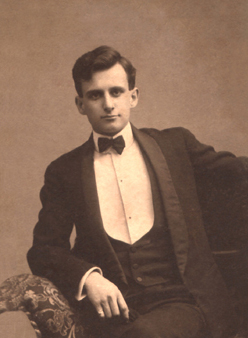
Jewett Bubar ca. 1907
|
|
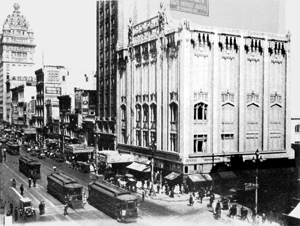
Bubar's first office was an open,
workshop-like affair on the street level
behind the California Theatre,
4th and Market Streets, San Francisco
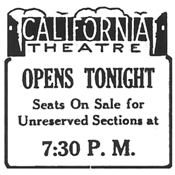
Opening Night ad for the
new California Theatre,
November 1, 1917
|
|
Bubar was offered a job working for Paramount Pictures as a commercial
artist by local stage show producer, Jack L. Partingon. For years
afterward, Bubar regarded Partington as the savior of his career.
The exact time must have been around November 1917, since that
was when the new California
Theatre at 4th and Market Streets in San Francisco - Bubar's
official studio was in the adjacent offices - first opened its
doors on November 1st of that year. Additionally, Bubar's daughter
recalls that he was already "established" in his job
at the California when the great Armistice Parade ending World
War I marched up Market Street (one of her earliest memories).
It was a time of great hope and optimism - both politically,
and from the standpoint of those who sought profit in the burgeoning
movie industry. From his California Theatre studio (on the street
level facing Fourth Street), Jewett Bubar began to turn out a
remarkable body of movie-based artwork
unique to the era.
The California Theatre had been built by attorney Herbert Rothschild
for whom Partington was working when he tapped Bubar to work for
them in 1917.
After four very successful years with the new California, Rothschild
built an even grander theatre palace, the Granada, three blocks
up Market, to the west. At 2,656 saets, the Granada had 256 more
seats than the California; both had 4-manual, 32-rank Wurlitzer
pipe organs, and both were at the heart of the thriving movie
exhibition industry in San Francisco.
It was here that Bubar moved into his first formal office, upstairs,
behind the theatre itself. Bubar was still working at the Granada
when all of Rothschild's theatres were sold to the Paramount-Publix
chain in the early 1920's. Bubar also stayed with his employer
through another buy-out, when Paramount was bought by William
Fox in 1928. In the largest theatre transaction up to that time,
Fox acquired California, Granada, Warfield, and St.Francis theatres.
The new company, Fox West Coast, remained Bubar's principal employer
for the rest of his career.
|
|
Bubar began his relationship with his new employer in 1928, and
was able to maintain his offices in San Francisco for a time. But,
soon the effects of the October 1929 stock market crash and the
widening great Depression that followed, came to Bubar's doorstep.
In 1933, he was encouraged by his Fox employers to take advantage
of president Roosevelt's new National Recovery Act (NRA) by forming
his own company with a fellow artist, Barrington Smith, in Oakland,
across the Bay from San Francisco (but nearer his home in Alameda).
The company would then utilize him as an outside contractor.
The new enterprise, Smith
and Bubar, had its offices above and behind the new Fox Oakland
Theatre on Telegraph avenue in downtown Oakland.
|
|
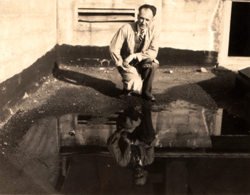
Jewett in his artist's smock on the roof
of the Granada Theatre, San Francisco
|
| |
|
|
 |
